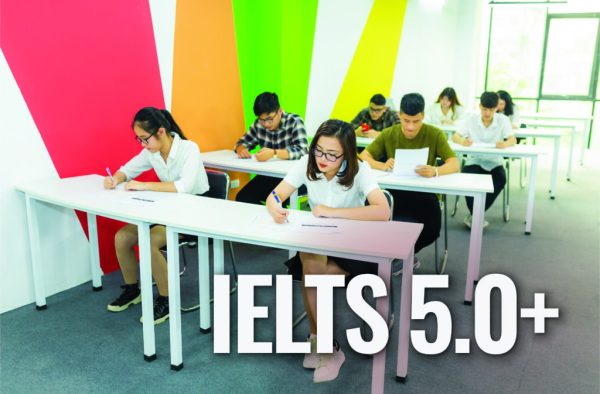Nhận tư vấn về lộ trình học
Plant ‘thermometer’ triggers springtime growth by measuring night-time heat
11 Tháng Mười Hai, 2023 | 408 lượt xem
Giải đề IELTS Reading Cambridge 16. Test 3. Passage 3. Plant ‘thermometer’ triggers springtime growth by measuring night-time heat. ‘Nhiệt kế’ thực vật kích hoạt tăng trưởng vào mùa xuân bằng cách đo nhiệt độ ban đêm.

A photoreceptor molecule in plant cells has been found to have a second job as a thermometer after dark – allowing plants to read seasonal temperature changes. Scientists say the discovery could help breed crops that are more resilient to the temperatures expected to result from climate change.
Người ta đã phát hiện một phân tử tế bào cảm quang trong tế bào thực vật có thêm một chức năng khác, đó là đóng vai trò như một nhiệt kế sau khi trời tối – cho phép thực vật cảm nhận được sự thay đổi nhiệt độ theo mùa. Các nhà khoa học cho biết phát hiện này có thể giúp nhân giống các loại cây trồng có khả năng phục hồi tốt hơn với nhiệt độ dự kiến do biến đổi khí hậu gây ra.
(Đoạn A)
(Question 27) An international team of scientists led by the University of Cambridge has discovered that the ‘thermometer’ molecule in plants enables them to develop according to seasonal temperature changes. Researchers have revealed that molecules called phytochromes — used by plants to detect light during the day actually change their function in darkness to become cellular temperature gauges that measure the heat of the night.
(Question 37) The new findings, published in the journal Science, show that phytochromes control genetic switches in response to temperature as well as light to dictate plant development.
Một nhóm các nhà khoa học quốc tế do Đại học Cambridge dẫn đầu đã phát hiện ra rằng phân tử ‘nhiệt kế’ trong thực vật cho phép chúng phát triển theo sự thay đổi nhiệt độ theo mùa. Các nhà nghiên cứu đã tiết lộ rằng các phân tử được gọi là phytochromes – được thực vật sử dụng để phát hiện ánh sáng vào ban ngày, đã thực sự thay đổi chức năng của chúng trong bóng tối để trở thành máy đo nhiệt độ tế bào đo nhiệt độ trong đêm.
Những phát hiện mới, được công bố trên tạp chí Khoa học, cho thấy rằng phytochrome kiểm soát các sự chuyển đổi về mặt gen để đáp ứng với nhiệt độ cũng như ánh sáng, theo đó quyết định sự phát triển của thực vật.
(Đoạn B)
At night, these molecules change states, and the pace at which they change is ‘directly proportional to temperature’, say scientists, who compare phytochromes to mercury in a thermometer. The warmer it is, the faster the molecular change — stimulating plant growth.
Vào ban đêm, các phân tử này thay đổi trạng thái và tốc độ thay đổi của chúng ‘tỷ lệ thuận với nhiệt độ’, các nhà khoa học so sánh phytochrome với thủy ngân trong nhiệt kế cho biết. Trời càng ấm thì sự thay đổi phân tử càng nhanh – kích thích sự phát triển của thực vật.
(Đoạn C)
(Question 36) Farmers and gardeners have known for hundreds of years how responsive plants are to temperature: warm winters cause many trees and flowers to bud early, something humans have long used to predict weather and harvest times for the coming year. The latest research pinpoints for the first time a molecular mechanism in plants that reacts to temperature — often triggering the buds of spring we long to see at the end of winter.
Nông dân và người làm vườn trong hàng thế kỷ qua đã biết thực vật phản ứng với nhiệt độ như thế nào: mùa đông ấm áp khiến nhiều cây và hoa đâm chồi sớm, điều mà con người từ lâu đã sử dụng để dự đoán thời tiết và thời điểm thu hoạch cho năm tiếp theo. Nghiên cứu mới nhất lần đầu tiên khẳng định chính xác một cơ chế phân tử ở thực vật phản ứng với nhiệt độ — thường kích hoạt các chồi của mùa xuân mà chúng ta mong đợi được thấy vào cuối mùa đông.
(Đoạn D)
With weather and temperatures set to become ever more unpredictable due to climate change, researchers say the discovery that this light-sensing molecule also functions as the internal thermometer in plant cells could help us breed tougher crops. (Question 28) ‘It is estimated that agricultural yields will need to double by 2050, but climate change is a major threat to achieving this. (Question 29) Key crops such as wheat and rice are sensitive to high temperatures. Thermal stress reduces crop yields by around 10% for every one degree increase in temperature,’ says lead researcher Dr Philip Wigge from Cambridge’s Sainsbury Laboratory. (Question 34) ‘Discovering the molecules that allow plants to sense temperature has the potential to accelerate the breeding of crops resilient to thermal stress and climate change.’
Với thời tiết và nhiệt độ trở nên khó dự đoán hơn bao giờ hết do biến đổi khí hậu, các nhà nghiên cứu cho biết việc phát hiện ra rằng phân tử cảm nhận ánh sáng này cũng hoạt động như nhiệt kế bên trong tế bào thực vật có thể giúp chúng ta nhân giống cây trồng khó khăn hơn. ‘Người ta ước tính rằng năng suất nông nghiệp sẽ cần tăng gấp đôi vào năm 2050, tuy nhiên biến đổi khí hậu là mối đe dọa lớn để đạt được điều này. Các loại cây trồng chính như lúa mì và gạo rất nhạy cảm với nhiệt độ cao. Ứng suất nhiệt làm giảm năng suất cây trồng khoảng 10% cho mỗi lần nhiệt độ tăng một độ,” trưởng nhóm nghiên cứu, Tiến sĩ Philip Wigge từ Phòng thí nghiệm Sainsbury của Cambridge cho biết. ‘Khám phá các phân tử cho phép thực vật cảm nhận được nhiệt độ có khả năng đẩy nhanh quá trình nhân giống các loại cây trồng có khả năng chống chịu với áp lực nhiệt và biến đổi khí hậu.’
(Đoạn E)
In their active state, phytochrome molecules bind themselves to DNA to restrict plant growth. (Question 31) During the day, sunlight activates the molecules, slowing down growth. If a plant finds itself in shade, phytochromes are quickly inactivated — enabling it to grow faster to find sunlight again. This is how plants compete to escape each other’s shade. ‘Light-driven changes to phytochrome activity occur very fast, in less than a second,’ says Wigge.
Ở trạng thái hoạt động, các phân tử phytochrome tự liên kết với DNA để hạn chế sự phát triển của thực vật. Vào ban ngày, ánh sáng mặt trời kích hoạt các phân tử, làm chậm quá trình tăng trưởng. Nếu cây trồng ở trong bóng râm, các sắc tố thực vật sẽ nhanh chóng bị vô hiệu hóa — cho phép cây phát triển nhanh hơn để tìm lại ánh sáng mặt trời. Đây là cách thực vật cạnh tranh để thoát khỏi bóng râm của các cây khác. Wigge cho biết: “Những thay đổi do ánh sáng điều khiển đối với hoạt động của sắc tố thực vật diễn ra rất nhanh, trong chưa đầy một giây.
(Question 32) At night, however, it’s a different story. Instead of a rapid deactivation following sundown, the molecules gradually change from their active to inactive state. This is called ‘dark reversion’. ‘Just as mercury rises in a thermometer, the rate at which phytochromes revert to their inactive state during the night is a direct measure of temperature,’ says Wigge.
Tuy nhiên, vào ban đêm, đó là một câu chuyện khác. Thay vì ngừng hoạt động nhanh chóng sau khi mặt trời lặn, các phân tử dần dần chuyển từ trạng thái hoạt động sang trạng thái tĩnh. Điều này được gọi là ‘đảo ngược bóng tối’. Wigge nói: “Giống như thủy ngân dâng lên trong nhiệt kế, tốc độ mà các sắc tố thực vật trở lại trạng thái không hoạt động trong đêm là thước đo trực tiếp của nhiệt độ.
(Đoạn F)
‘The lower the temperature, the slower the rate at which phytochromes revert to inactivity, so the molecules spend more time in their active, growth-suppressing state. This is why plants are slower to grow in winter. Warm temperatures accelerate dark reversion, so that phytochromes rapidly reach an inactive state and detach themselves from the plant’s DNA — allowing genes to be expressed and plant growth to resume.’ Wigge believes phytochrome thermo-sensing evolved at a later stage, and co-opted the biological network already used for light-based growth during the downtime of night.
‘Nhiệt độ càng thấp, tốc độ mà các sắc tố thực vật trở lại trạng thái không hoạt động càng chậm, do đó, các phân tử dành nhiều thời gian hơn ở trạng thái hoạt động, kìm hãm sự phát triển của chúng. Đây là lý do tại sao thực vật phát triển chậm hơn vào mùa đông. Nhiệt độ ấm lên đẩy nhanh quá trình đảo ngược màu tối, do đó các sắc tố thực vật nhanh chóng đạt đến trạng thái không hoạt động và tự tách ra khỏi DNA của thực vật — cho phép các gen được biểu hiện và sự phát triển của thực vật tiếp tục.’ mạng lưới sinh học đã được sử dụng để phát triển dựa trên ánh sáng trong thời gian chết của ban đêm.
(Đoạn G)
Some plants mainly use day length as an indicator of the season. Other species, such as daffodils, have considerable temperature sensitivity, and can flower months in advance during a (Question 38) warm winter. (Question 35) In fact, the discovery of the dual role of phytochromes provides the science behind a well-known rhyme long used to predict the coming season: oak before ash we’ll have a splash, ash before oak we’re in for a soak.
Một số loài thực vật chủ yếu dựa vào độ dài ngày như một dấu hiệu nhận biết về mùa. Các loài khác, chẳng hạn như hoa thủy tiên vàng, có độ nhạy nhiệt độ đáng kể và có thể ra hoa trước nhiều tháng trong mùa đông ấm áp. Trên thực tế, tức là việc khám phá ra vai trò kép của phytochromes cung cấp cơ sở khoa học đằng sau một câu nói nổi tiếng từ lâu được sử dụng để dự đoán mùa sắp tới, tạm dịch là: nếu lá cây sồi xuất hiện trước lá cây tần bì, mùa hè sẽ khô hạn; nếu ngược lại mùa hè sẽ nhiều mưa.
Wigge explains: ‘Oak trees rely much more on temperature, likely using phytochromes as thermometers to dictate development, whereas ash trees rely on measuring day length to determine their seasonal timing. A warmer spring, and consequently a higher likeliness of a hot summer, will result in oak leafing before ash. A cold spring will see the opposite. As the British know only too well, a colder (Question 39) summer is likely to be a rain-soaked one.’
Wigge giải thích: ‘Cây sồi phụ thuộc nhiều hơn vào nhiệt độ, có khả năng sử dụng phytochromes làm nhiệt kế để xác định sự phát triển, trong khi cây tần bì dựa vào việc đo độ dài ngày để xác định thời gian theo mùa của chúng. Một mùa xuân ấm áp hơn, và do đó khả năng xảy ra một mùa hè nóng bức cao hơn, sẽ dẫn đến việc lá sồi rụng trước lá tần bì. Một mùa xuân lạnh giá sẽ thấy điều ngược lại. Như người Anh đã biết rõ, một mùa hè lạnh hơn có thể sẽ ướt đẫm mưa.”
(Đoạn H)
The new findings are the culmination of twelve years of research involving scientists from Germany, Argentina and the US, as well as the Cambridge team. The work was done in a model system, using a (Question 40) mustard plant called Arabidopsis, but Wigge says the phytochrome genes necessary for temperature sensing are found in crop plants as well. ‘Recent advances in plant genetics now mean that scientists are able to rapidly identify the genes controlling these processes in crop plants, and even alter their activity using precise molecular “scalpels”,’ adds Wigge. (Question 33) ‘Cambridge is uniquely well-positioned to do this kind of research as we have outstanding collaborators nearby who work on more applied aspects of plant biology, and can help us transfer this new knowledge into the field.’
Những phát hiện mới là đỉnh cao của mười hai năm nghiên cứu liên quan đến các nhà khoa học từ Đức, Argentina và Mỹ, cũng như nhóm Cambridge. Công việc được thực hiện trong một hệ thống mô hình, sử dụng cây mù tạt có tên là Arabidopsis, nhưng Wigge cho biết các gen phytochrome cần thiết cho cảm biến nhiệt độ cũng được tìm thấy trong cây trồng. “Những tiến bộ gần đây trong di truyền học thực vật hiện nay có nghĩa là các nhà khoa học có thể nhanh chóng xác định các gen kiểm soát các quá trình này trong cây trồng và thậm chí thay đổi hoạt động của chúng bằng cách sử dụng “dao mổ” phân tử chính xác,’ Wigge cho biết thêm. ‘Cambridge có vị trí thuận lợi duy nhất để thực hiện loại nghiên cứu này vì chúng tôi có những cộng tác viên xuất sắc ở gần đó, những người nghiên cứu về các khía cạnh ứng dụng hơn của sinh học thực vật và có thể giúp chúng tôi chuyển kiến thức mới này vào lĩnh vực này.’
Danh mục
Giải thích đáp án các câu 27-32
Câu 27:
The Cambridge scientists’ discovery of the ‘thermometer molecule’ caused surprise among other scientists.
=> Đáp án Câu 27: NOT GIVEN
Dẫn chứng trong đoạn A:
An international team of scientists led by the University of Cambridge has discovered that the thermometer’ molecule in plants enables them to develop according to seasonal temperature changes.
Đoạn văn có nhắc đến các từ khóa Cambridge scientists và thermometer molecule, tuy nhiên không nhắc đến thông tin rằng phát hiện này khiến cho các nhà khoa học ngạc nhiên (caused surprise among other scientists).
Câu 28:
The target for agricultural production by 2050 could be missed.
=> Đáp án Câu 28: TRUE
Dẫn chứng trong đoạn D:
Thông tin trùng khớp trong câu hỏi và trong bài văn:
| Trong câu hỏi:the target…by 2050agricultural productioncould be missed | Trong bài văn to double by 2050agricultural yieldsthreat to achieving this |
Câu 29:
Wheat and rice suffer from a rise in temperatures.
=> Đáp án Câu 29: TRUE
Dẫn chứng trong đoạn D:
Thông tin trùng khớp trong câu hỏi và trong bài văn:
| Trong câu hỏi:suffer froma rise in temperatures | Trong bài văn sensitive tohigh temperatures |
Câu 30:
It may be possible to develop crops that require less water.
=> Đáp án Câu 30: NOT GIVEN
Không có dẫn chứng trong bất cứ đoạn văn nào của bài về việc cây trồng cần ít nước hơn (require less water).
Câu 31:
Plants grow faster in sunlight than in shade.
=> Đáp án Câu 31: FALSE
Dẫn chứng trong đoạn E:
Thông tin đối lập trong câu hỏi và trong bài văn:
| Trong câu hỏi:Plants grow faster in sunlight than in shade | Trong bài văn sunlight activates the molecules, slowing down growth; a plant… in shade… grow faster to find sunlight again |
Câu 32:
Phytochromes change their state at the same speed day and night.
=> Đáp án Câu 32: FALSE
Dẫn chứng trong đoạn E:
Thông tin đối lập trong câu hỏi và trong bài văn:
| Trong câu hỏi:Phytochromes change their stateat the same speed day and night | Trong bài văn molecules gradually change from their active to inactive stateInstead of a rapid deactivation following sundown, … gradually change |
Giải thích đáp án các câu 33-37
Câu 33:
mention of specialists who can make use of the research finding
=> Đáp án Câu 33: H
Dẫn chứng trong đoạn H:
‘Cambridge is uniquely well-positioned to do this kind of research as we have outstanding collaborators nearby who work on more applied aspects of plant biology, and can help us transfer this new knowledge into the field.’
specialists = outstanding collaborators
make use of the research finding = transfer this new knowledge into the field
Câu 34:
a reference to a potential benefit of the research findings
=> Đáp án Câu 34: D
Dẫn chứng trong đoạn D:
‘Discovering the molecules that allow plants to sense temperature has the potential to accelerate the breeding of crops resilient to thermal stress and climate change.
a potential benefit = has the potential to accelerate the breeding of crops
the research findings = discovering the molecules
Câu 35:
scientific support for a traditional saying
=> Đáp án Câu 35: G
Dẫn chứng trong đoạn G:
In fact, the discovery of the dual role of phytochromes provides the science behind a well-known rhyme long used to predict the coming season: oak before ash we’ll have a splash, ash before oak we’re in for a soak.
scientific support = provides the science behind
a traditional saying = a well-known rhyme long used
Câu 36:
a reference to people traditionally making plans based on plant behaviour
=> Đáp án Câu 36: C
Dẫn chứng trong đoạn C:
Farmers and gardeners have known for hundreds of years how responsive plants are to temperature: warm winters cause many trees and flowers to bud early, something humans have long used to predict weather and harvest times for the coming year.
people = farmers and gardeners
traditionally making plans = have long used to predict weather and harvest times for the coming year
plant behaviour = warm winters cause many trees and flowers to bud early
Câu 37:
a reference to where the research has been reported
=> Đáp án Câu 37: A
Dẫn chứng trong đoạn A:
The new findings, published in the journal Science, show that…
research = findings
where = in the journal Science
reported = published
Questions 38-40:
Complete the sentences below.
Choose NO MORE THAN TWO WORDS from the passage for each answer.
Câu 38:
Daffodils are likely to flower early in response to ………………….. weather.
=> Đáp án Câu 38: warm
Dẫn chứng trong đoạn G:
Other species, such as daffodils, have considerable temperature sensitivity, and can flower months in advance during a warm winter.
flower early = flower months in advance
winter = weather
Câu 39:
If ash trees come into leaf before oak trees, the weather in ………………….. will probably be wet.
=> Đáp án Câu 39: summer
Dẫn chứng trong đoạn G:
A warmer spring, and consequently a higher likeliness of a hot summer, will result in oak leafing before ash. A cold spring will see the opposite. As the British know only too well, a colder summer is likely to be a rain-soaked one.
ash trees come into leaf before oak trees = the opposite, oak leafing before ash
probably be wet = likely to be a rain-soaked one
Câu 40:
The research was carried out using a particular species of …………………..
=> Đáp án Câu 40: mustard
Dẫn chứng trong đoạn H
The work was done in a model system, using a mustard plant called Arabidopsis
The research was carried out = The work was done
a particular species of mustard = a mustard plant called Arabidopsis
Bí quyết chinh phục IELTS Reading
Để đạt điểm cao trong IELTS Reading, bạn nên nắm rõ tips và chiến lược để làm bài với từng dạng đề cụ thể. Dù scanning và skimming là 2 kỹ năng nhất định phải dùng trong bài thi IELTS nhưng tùy từng dạng, chúng ta sẽ áp dụng ở những bước khác nhau.
Hãy tiếp tục theo dõi chuyên mục IELTS Reading của Universal Language Center và cùng tìm hiểu bí quyết chinh phục từng dạng đề thi IELTS Reading bạn nhé!
Để liên tục đánh giá trình độ hiện tại, hãy tham khảo bài thi tại đây: http://m.me/universal.edu.vn/
Hoặc tham dự thi thử bài thi IELTS IDP miễn phí tại các cơ sở của Universal Language Center:
- Cơ Sở 01: 262 Lạc Trung, Hai Bà Trưng, Hà Nội
- Cơ Sở 02: 114 Hoàng Như Tiếp, Long Biên, Hà Nội
- Cơ Sở 03: 12/36 Phan Kế Bính, Ba Đình, Hà Nội
- Cơ Sở 04: 619 Nguyễn Văn Cừ, Long Biên, Hà Nội
- Cơ Sở 05: 23 Tô Vĩnh Diện, Thanh Xuân, Hà Nội
- Cơ Sở 06: 222 Lý Nam Đế, Tân Quang, Tuyên Quang
- VPTNĐK: 1/58 Việt Hưng, Long Biên, Hà Nội
Tham khảo khóa học IELTS Cam kết đầu ra 7.5+ tại Universal: https://universal.edu.vn/khoa-hoc/khoa-hoc-ielts-mastery/
ĐĂNG KÝ NHẬN TIN






